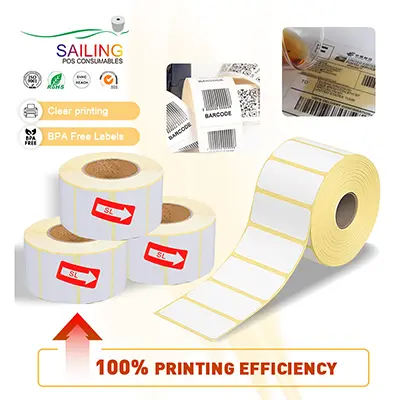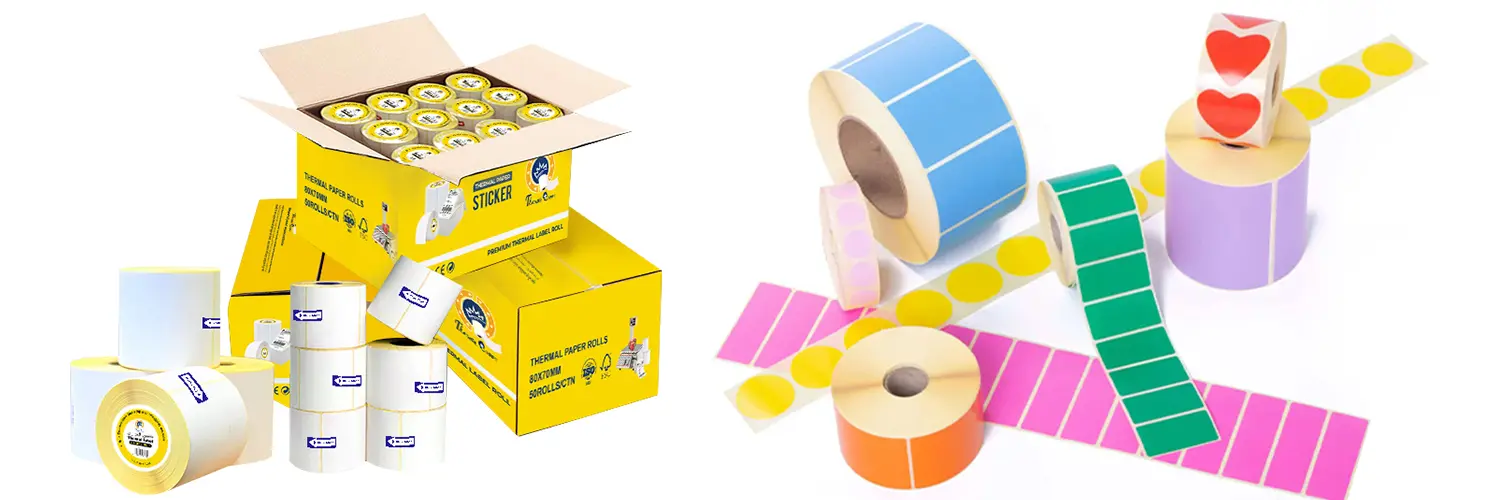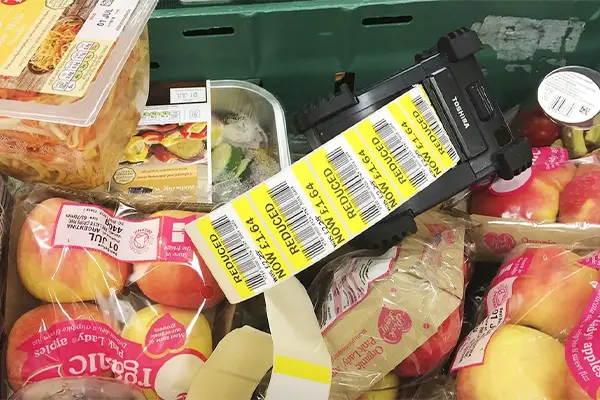Eco-Friendly Labeling: The Rise of Sustainable Thermal Sticker Paper
Now-a-days, almost all the branches of industries throughout the world are adopting greener practices for the sake of lesser impact on the environment. Labelling is not an exception; this is one of the very significant areas that can be missed while talking about green practices. Generally speaking, whether in retail or in logistics, healthcare or e-commerce, labels are being used in huge numbers. Olden day solutions for labelling are effective, but many contain harmful chemicals like BPA and are not biodegradable. Thermal sticker paper is chosen by companies as one of the extensive eco-friendly alternatives for labeling where consumer and regulatory demand for sustainability is increasing.
Understanding Thermal Sticker Paper
Thermal sticker paper is a type of special paper that creates printed images from the effect of heat, eliminating the need for ink or toner. Primarily, it is used in direct thermal printing, suitable for short-term applications such as shipping and barcode labels. The easy printing process and economy make it a preferred option in various sectors.
Eco-friendly versions of thermal paper are usually BPA-free and made from responsible materials. Such greener options ensure that the use of thermal printer sticker paper does not violate environmental values. Other advances in recyclable substrates have allowed the bridging of performance and sustainability.

Environmental Impact of Traditional Labeling
Conventional thermal papers typically incorporate BPA or BPS as a developer; both have health and environmental concerns. These substances are hazardous when they leach into the environment or come in direct skin contact. Safety levels become higher with more use of labels on shipping labels Amazon products or food packaging.
Moreover, conventional tags cause landfill waste because they can't be recycled easily due to their chemical coatings. With rising demand in sustainable packaging characteristics, labels began to take birth into the list of requirements; hence, companies are changing their practices to be sustainable by adopting sticker thermal paper.
Why Switch to Eco-Friendly Thermal Sticker Paper?
3.1. Sustainability that does not compromise quality
Modern eco-friendly thermal papers possess print clarity and adhesion comparable to their conventional counterparts. Labels are always legible and remain undistorted even under varied temperature or humidity, thus making thermal printing applications ideal for logistic label printing.
3.2. Broad Based Applications
With optimum return shipping label solutions and warehouse tracking, sustainable thermal labels are serving a large number of industries. E-commerce is one such example, with it having the biggest application as most of their items and packages require such labeling to be effective, readable, and environment-friendly.
3.3. Cost-Effective
Those sustainable thermal papers are cost-effective as regards eco-friendly products. Buying bulk applies to thermal labels, which helps lower the price per label and hence will ensure their steady supply for high-demand businesses.
Applications in Different Industries
4.1. E-Commerce and Retail
Retailers and online sellers particularly on platforms of Amazon need shipping labels that are easy to print and apply. Eco-friendly 4 x 6 thermal labels serve these purposes and aim toward sustainability goals. The products sold with self addressed shipping label options are more consumer-friendly and green-initiative compliant.
4.2. Logistics and Warehousing
A tough labeling solution is required in logistics in order to facilitate proper inventory control. Eco-friendly stickering solutions ensure durability and clarity at all times, whether it's 2x2 thermal labels for small items or large thermal label 4 x 6 tags for pallets. With eco-paper used in logistics shipping labels, the carbon footprint of the supply chains is minimized.
4.3. Healthcare and Pharmaceuticals
In the healthcare sector, the right labeling and safety are of utmost importance. Eco-friendly thermal stickers are BPA free and would be applicable for medication, test tubes, and specimen tracking. Using A4 address label templates for patient records or files would also improve operational efficiency.
Varieties of Thermal Sticker Paper
5.1 By Size
● 2 x 4 shipping labels: Suitable for barcodes for retail and for packages of medium size.
● 100 x 150 Thermal Labels: Used most frequently in relation to international shipping.
● 58mm thermal label: Designed for compact thermal printers, this paper size is commonly used for small-format receipts and labels. It provides quick heat sensitivity and clear print quality, making it ideal for limited-space applications where accuracy matters.
5.2 By Color
Colored shipping labels not only help categorize visually but can also be used as part of the branding of a company. Available in chosen shades, the labels function exactly like the standard white labels, except in better organizing printed matter.
5.3 By Format
● Thermal sticker rolls: Using high volumes, these refer to much of the label printers compatibility.
● A4 paper sticker label: Ideal for desk usage and manual labeling in offices and laboratories.
Innovations in Thermal Label Design
And as expectations grow around labeling systems, thermal label design continues to evolve within its practical limits. Features now include tamper-evidence, water-resistance for short-term use, and compatibility with mobile printers. Innovations in eco-adhesives aim to leave minimal residue while maintaining strong adhesion. While thermal labels are not ideal for long-term outdoor or high-heat environments—since exposure to sunlight and moisture can cause fading—brands like Sailingpaper focus on optimizing performance for indoor, short-cycle logistics and shipping needs. These improvements are expanding the usefulness of thermal labels in controlled conditions where speed, sustainability, and clarity are key.
How to Choose the Right Thermal Sticker Paper
In choosing the coherent sustainable labels, consider the following points:
● Material Type: Must be BPA-free and recyclable.
● Printer Compatibility: The label format should be checked against your thermal printer.
● Application Needs: Labels with the right durability and resistance should be chosen according to your environment.
● Label Size: The label dimensions must be appropriate for their packaging, such as A4 address label template or smaller sizes such as 2x2 thermal labels.
Adhesive strength should also be checked in accordance with the surfaces to which you will be applying labels, checking if water-resistant or oil-resistant coatings are required. At this point, check reviews from other users and consider buying samples to test before ordering in bulk for the best choice according to training your own operations.
Printing Tips for Best Results
The usage of eco-friendly thermal paper may not necessarily change your printing procedure, but expressly changing your exact parameters will influence performance:
● Use printers set to the different temperature settings based on your label type.
● Store paper in a cool and dry place to secure its quality.
● Regularly clean your printer to provide an ideal printing result.
● Periodically check your print head alignment to lessen chances of faded edges or incomplete prints.
● Every time you switch the type of paper, always do a few test prints to optimize your printer settings for maximum clarity and adhesion.
These common sense steps would not only prolong the lifespan of your printer, but also ensure that all your prints would be absolutely top-quality. Following these methods gives brands such as Sailingpaper good, consistent results over their daily activities to
Future Trends in Eco Labeling
The journey is still in its infancy when it comes to sustainable labeling. Look ahead and expect to see a lot more of the following:
● Narrower spaces for applications of thermal label designs for very specific industries.
● Greater use of recycled and compostable materials.
● Wider compatibility with smart label systems and QR code tracking.
● AI inventory systems with scanned logistics shipping labels.
● Water-activated adhesives erasing the necessity of liners and yet reducing waste.
● The increase in using blockchain-the way to verify the sourced and recyclable nature of labeling materials, hence adding transparency to supply chains.
Adoption of rational developments into blockchain for proof of the source and recyclability of labeling materials adding even more value to supply chains. Consumer demand for transparency and sustainability will continue to thrive and be viciously competitive for those companies engaging in such future-oriented practices. Already, companies like Sailingpaper are taking part in leading this transformational trend by providing innovative, eco-conscious labeling solutions.
Conclusion
Sustainable labeling has ceased being a luxury and has become a necessity. Eco-friendly thermal sticker paper will reduce your environmental footprint while ensuring operational efficiencies for the e-commerce seller, manufacturer, or logistics provider alike. There is a sustainable solution for every need, whether shipping labels for Amazon products or optimizing return shipping label systems. The companies can seamlessly support the Earth's health by using future paper options such as the recyclable thermal paper sticker roll that is BPA-free without compromising any performance level aspects.
Available in variable sizes from 100 x 150 thermal labels to small 58mm sticker thermal paper and an assortment of colorful 4 x 6 color thermal labels, eco-friendly options abound for any assignment. Let your labels speak not only to your brand's professional approach but to its value system. Switch today for a clean and intelligent planet.

Get In touch!
Are you ready to stride towards sustainable labeling? Whether you need to place an order for bulk environmentally friendly thermal labels, or if you have certain questions in mind regarding product compatibility, Sailingpaper here to assist. Our experts can help you choose the right thermal sticker paper to meet your specific industry requirements.
FAQs About Thermal Sticker Paper
1. For what does thermal sticker paper stand?
Thermal sticker paper is basically a self-adhesive paper where you print the labels like barcodes, shipping tags, and product tags without using inks and toners. It is mainly used in retail, logistics, and e-commerce.
2. Can thermal sticker paper be termed eco-friendly?
Not all types of thermal papers are ecologically friendly; however, most thermal sticker paper manufacturers in many parts of the world have gone the extra mile and developed a BPA-free and recyclable thermal sticker paper that is safe for users and the environment.
3.What are the common applications of thermal sticker paper?
Thermal sticker paper finds applications mainly in shipping labels, barcode stickers, return address labels, price tags, and warehouse logistics tags. Quick printing without using ink suits thermal sticker applications in the fast-moving atmosphere of e-commerce fulfillment centers or retail stores.
4. What size do thermal labels have for shipping?
The most sought-after sizes are 4 x 6 color thermal labels, 2 x 4 shipping labels, and 100 x 150 thermal labels, depending on how small or large your packaging measurements are, and the capability of your printer.
5. Which printer should be used with thermal sticker paper?
As a starting point, you will need a direct thermal or thermal transfer printer for thermal printer sticker paper. Models vary by the size of label being printed as well as volume of printing.
6. Are thermal labels good for bulk printing?
Of course. Bulk thermal labels are specially designed to withstand the rigors of heavy-duty printing and can be bought in rolls or fanfold stacks thereby making them essential for commercial and industrial establishments.






 Thermal labels
Thermal labels


